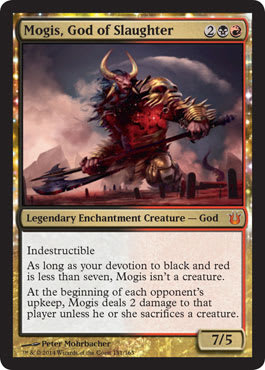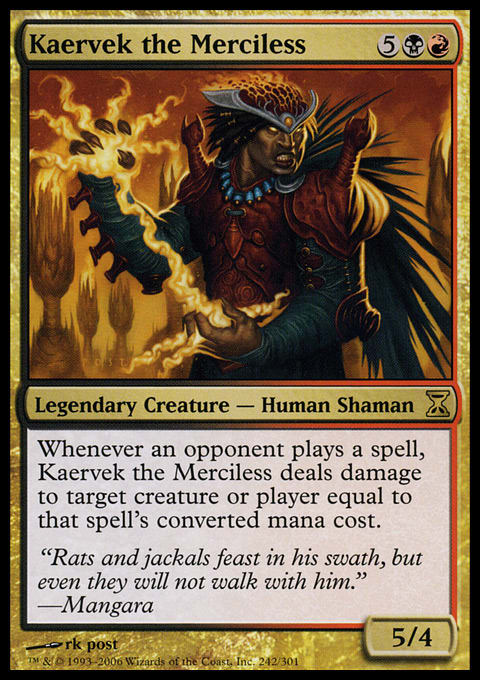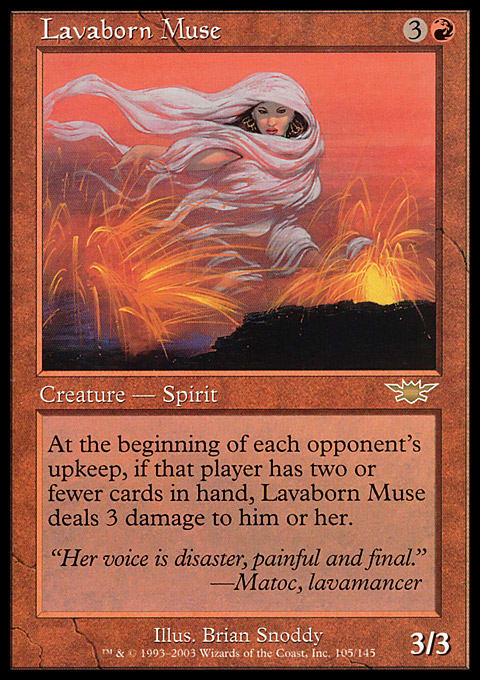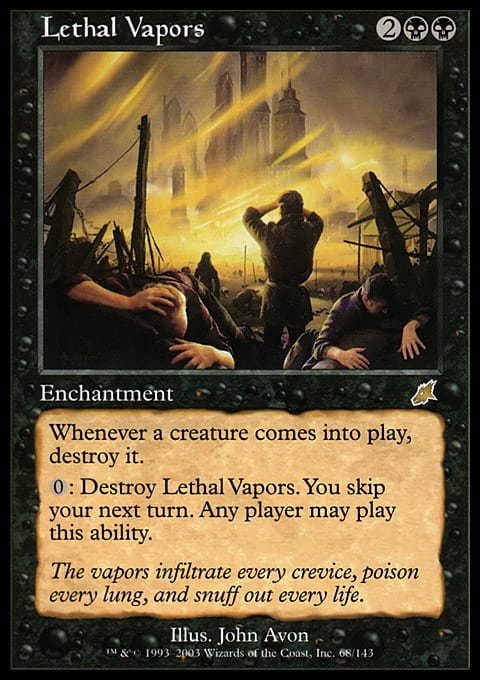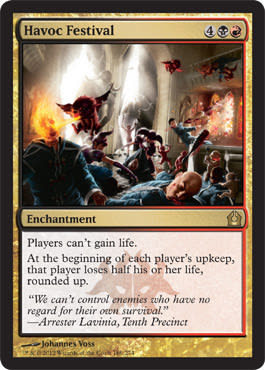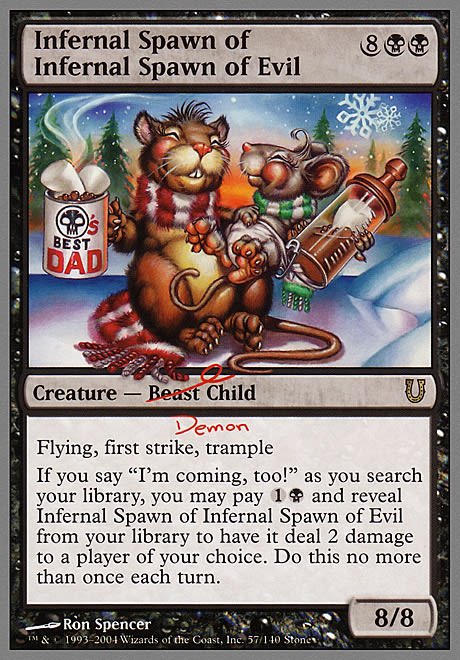Way back on January 27, the Head Designer of Magic: the Gathering did one of his weekly podcasts, called Drive to Work, on Evaluation. Mark Rosewater pointed out how he has talked at length about the process of designing cards and sets, but he’d never really dealt with the question of “how do we know when something is good?”
He spent the rest of his, well, drive to work talking about how R&D determines when they have a winner, whether a mechanic or a card. I won’t steal his thunder, but the first criterion he talked about is whether or not it evokes a “positive emotional response.” But he’s playing with us, because positive doesn’t necessarily mean “happy” or “excited.” For example, we go to scary movies to be scared, and if we’re scared, we’ve achieved the positive emotional response we wanted. When Wizards created Innistrad, the goal was to create fear in players. That’s why a mechanic like Morbid worked; normally, when your opponent in a limited game swings in to a larger blocker, you can assume your opponent has a combat trick. But with Morbid, maybe they want the creature to die so something else worse will happen. Yikes!
While listening to this podcast, I was contemplating the next deck to build for this column, and immediately recalled a game I played recently where we all ended up dying to an unanswered Mogis, God of Slaughter. That little guy can really sneak up on a table, just picking away at everyone’s life total. That got me thinking: what if we used an entire deck to create a “positive” emotional response of terror . . . just like Innistrad? Let’s make our opponents think each new card is opening the maw of Hades wider and threatening to draw them down. But we are playing with the idea of why we build decks at the same time. Winning is less important to this deck than most. We want our opponents to start hearing the theme music of The Walking Dead or, if they are older, Jaws, and being really nervous. So cue the sound track.
Mogis, God of Slaughter ? Commander | Mark Wischkaemper
- Commander (1)
- 1 Mogis, God of Slaughter
- Creatures (16)
- 1 Archfiend of Depravity
- 1 Desecration Demon
- 1 Fate Unraveler
- 1 Forgeborn Oreads
- 1 Greater Gargadon
- 1 Grim Guardian
- 1 Indulgent Tormentor
- 1 Kaervek the Merciless
- 1 Lavaborn Muse
- 1 Nezumi Shortfang
- 1 Ob Nixilis, Unshackled
- 1 Servant of Tymaret
- 1 Sin Prodder
- 1 Sire of Insanity
- 1 Thoughtrender Lamia
- 1 Tree of Perdition
- Instants (1)
- 1 Terminate
- Sorceries (11)
- 1 Arc Blade
- 1 Blood Tithe
- 1 Capital Punishment
- 1 Curse of the Cabal
- 1 Deadly Tempest
- 1 Dreadbore
- 1 Killing Wave
- 1 Phthisis
- 1 Skull Rend
- 1 Syphon Mind
- 1 Wheel of Fate
- Enchantments (21)
- 1 Baneful Omen
- 1 Daxos's Torment
- 1 Everlasting Torment
- 1 Grave Betrayal
- 1 Havoc Festival
- 1 Lethal Vapors
- 1 Manabarbs
- 1 Megrim
- 1 Painful Quandary
- 1 Palace Siege
- 1 Polluted Bonds
- 1 Shrieking Affliction
- 1 Spellshock
- 1 Spiteful Visions
- 1 Subversion
- 1 Sulfuric Vortex
- 1 Tainted Aether
- 1 Tainted Remedy
- 1 Underworld Dreams
- 1 Waste Not
- 1 Wound Reflection
- Artifacts (10)
- 1 Cryptolith Fragment
- 1 Fellwar Stone
- 1 Kolaghan Monument
- 1 Lantern of Insight
- 1 Mind Stone
- 1 Mindcrank
- 1 Rakdos Cluestone
- 1 Rakdos Keyrune
- 1 Rakdos Signet
- 1 Thought Vessel
- Lands (40)
- 15 Swamp
- 6 Mountain
- 1 Akoum Refuge
- 1 Bloodfell Caves
- 1 Bojuka Bog
- 1 Cinder Barrens
- 1 Dragonskull Summit
- 1 Evolving Wilds
- 1 Geier Reach Sanitarium
- 1 Lavaclaw Reaches
- 1 Leechridden Swamp
- 1 Rakdos Carnarium
- 1 Rakdos Guildgate
- 1 Rix Maadi, Dungeon Palace
- 1 Shadowblood Ridge
- 1 Shivan Gorge
- 1 Tainted Peak
- 1 Temple of Malice
- 1 Temple of the False God
- 1 Terramorphic Expanse
- 1 Urborg Volcano
We start, as normal, with our 40 lands and some rocks, to make sure we can cast our spells. Usually we look for some utility in our lands, because abilities on lands are effectively free spells. Here we’ve got a few, scary ones, not just using them for the sake of a helpful ability. Urborg Volcano can be frightening with the right few cards on the table; Homeward Path can’t. Geier Reach Sanitarium has an alarming ability to terrify when every card drawn and discarded does more damage. Rocks are a bit more limited, at least in terms of theme, but at least Rakdos Keyrune and Kolaghan Monument can turn into creatures, as can Cryptolith Fragment.
From here, we’d normally talk about card draw, threats, and answers, before jumping into synergy. But when we take on an experiment like this one, where our goal is less about winning and more about creating an experience, once we have a mana base which can support our spells, we just kind of go with it. We really want as much as possible to be about making our opponents nervous, and if something happens to threaten or answer, well, that’s just luck. Instead, let’s walk through the various pieces of the deck and what it’s trying to do.
First up is a pretty serious enchantment theme. There are a couple of reasons. First, enchantments are reliably difficult to deal with, so our scary stuff is more likely to lurk for a while; the enchantments work more like that frightening theme music of successful horror movies, constantly building the pressure. And there are some really scary things we can do with enchantments in ![]()
![]() . Because Mogis himself is an enchantment, we can play with a small Constellation theme to make things even more alarming. But they come at a cost, because several of the enchantments will hurt us, too.
. Because Mogis himself is an enchantment, we can play with a small Constellation theme to make things even more alarming. But they come at a cost, because several of the enchantments will hurt us, too.
Next we’ve got some damage. We’ve got ways to just keep doing damage, turn after turn, and in ways which make it ever more difficult for our opponents to do what they want. Creatures like Servant of Tymaret keep whacking away at life totals (we can pay the Regenerate cost at end-of-turn to tap him so he untaps at the beginning of our turn), while dudes like Kaervek the Merciless look like they are straight from Hell and make it challenging to play spells. We make it hurt to draw (Underworld Dreams), discard (Megrim), tap for mana (Manabarbs), and then we make it hurt some more (Wound Reflection). By the time we’re knocked out of the game, it’s unlikely we’ll have long to wait to shuffle up for a new one because everyone’s life total will be low.
We’ve also got some cards which make it tough to keep creatures around like Lethal Vapors, which is just chilling. Cards like Sire of Insanity force everyone to discard their entire hand every turn, which is rather terrorizing. Painful Quandary and Spellshock are both like mini Kaerveks. Polluted Bonds does a good job of helping us stay alive, unless we’ve already played one of a few ways to prevent any life gain, like, say, Everlasting Torment. Havoc Festival does that too, but it’s worse because it also makes everyone lose half their life, rounded up, on each of their upkeeps. Even that rounding can be important because if one has 17 life, half rounded up is 9, putting one at 8. More importantly, if one is at 1, half rounded up is 1, which means they’ll just die. Ouch.
Ob Nixilis, Unshackled is dreadful for the Green ramp player, and Lavaborn Muse supports our discard theme. Baneful Omen and Lantern of Insight both give us opportunities to reveal our top card, which can just be fun. When you leave that top card flipped up and it’s Grave Betrayal, people start to get nervous.
Finally, in terms of general themes, we’ve got a few cards with Suspend; they will keep people in suspense. Greater Gargadon ticks down every turn, as does Curse of the Cabal. Add a meaningful glare whenever someone does something to hurt you for extra fear. Phthisis is a fun one, especially if an opponent’s been working really hard to hold on to a creature, because, well, there it goes. Revel in the inevitable distress as these cards count down their way into existence.
I looked for ways to reveal cards from our hand, but few exist in these colors, so we had to stick with the top-of-the-library revealers. This may be a deck where you want to “inadvertently” drop and reveal a card just to ratchet up the tension. But the key to playing a deck like this is to live it. You don’t laugh, you cackle when something horrible is revealed off the top. Give a demonic grin as you pitch your own hand to Sire of Insanity. Act as if everything is part of the plan to make your opponents suffer, even if it’s not. There may not be a way to make anyone discard anywhere in sight, but that Lavaborn Muse can still make everyone nervous. Make opponents think it’s all part of a dastardly plan and they should be terrified of everything.
The way we convert this deck doesn’t really change how it works, but it’s one I’ve wanted to do for quite a while. The problem is, it breaks the rules. No, literally — it’s actually against the rules of Commander, so you’re going to have to get special permission from your playgroup to run the alternate version. Of the 10 cards in our optionboard which really just give some variance, four of them have silver borders.
- Detritivore
- Herald of Anguish
- Roiling Horror
- Infernal Spawn of Evil
- Infernal Spawn of Infernal Spawn of Evil
- Pointy Finger of Doom
- The Ultimate Nightmare of Wizards of the Coast® Customer Service
- Ob Nixilis of the Black Oath
- Mindstab
- Tempt with Immortality
Detritivore strikes fear into the most invested player, because destroying their precious $1K mana base is horrible for them. Herald of Anguish, currently only available in preview form, will be a fun addition should you feel like swapping it in. Mindstab, Ob Nixilis of the Black Oath — these are scary cards and deserve to be hanging around this deck. Options are good.
But Infernal Spawn of Evil? How do you get better than revealing a card from your hand every turn and saying “it’s coming”? Perhaps the only way is with Infernal Spawn of Infernal Spawn of Evil, which we can’t use often because we don’t have a ton of ways to search our library, but hey, it’ll be hilarious when it happens. Plus, if we happen into an early Terramorphic Expanse, we can start off the funny early to get everyone in the right mindset. Pointy Finger of Doom will have everyone begging that it not land on any of their stuff. And The Ultimate Nightmare of Wizards of the Coast® Customer Service will be very funny if it’s revealed because everyone will think we’ve got a ![]() card in our deck, plus with enough mana we can actually do some damage with it. (Note how complicated it is, with three distinct variables of X, Y and Z. So, if we have 11 mana, we can pay
card in our deck, plus with enough mana we can actually do some damage with it. (Note how complicated it is, with three distinct variables of X, Y and Z. So, if we have 11 mana, we can pay ![]()
![]() , then four into X, two into Y, and three into Z, so we deal four damage to two different creatures and three different players.)
, then four into X, two into Y, and three into Z, so we deal four damage to two different creatures and three different players.)
What have you done to create an experience for your table? Have you ever built a deck where the point was not to win? What would you do here to heighten the fear?
The biggest key to playing a deck like this is remembering the point isn’t to win. Set your mind on creating some terror in the minds of your friends, and when that’s achieved, call it a victory. Do try it with the Un-set cards, but only with permission. And practice that evil laugh.
Total cost of main deck: $98.59
Total cost of optionboard: $25.67 (yup, it’s over by $0.67, but we make up for it in the final total)
Total cost of both: $124.26













